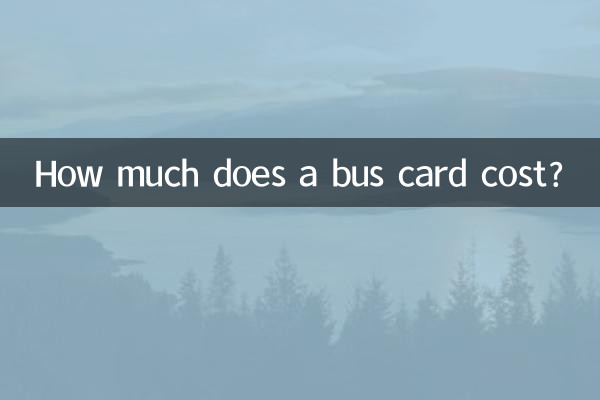How much does a bus card cost: Hot topics across the Internet and structured data analysis
Recently, "How much does a bus card cost?" has become one of the hot topics among netizens. With the popularity of public transportation and the rise of digital payment, the price, functions and preferential policies of bus cards have attracted much attention. This article will combine the hot content of the entire network in the past 10 days to provide you with a detailed analysis of bus card prices and related information, and provide structured data for reference.
1. Overview of bus card prices

The price of bus cards varies depending on the city, type (regular card, student card, senior card, etc.) and function (whether it supports transportation combination). The following is the selling price and deposit situation of some city bus cards:
| City | Price of ordinary card (yuan) | Deposit (yuan) | Remark |
|---|---|---|---|
| Beijing | 20 | 20 | Refundable deposit |
| Shanghai | 20 | 20 | Transportation joint version requires an additional 10 yuan |
| Guangzhou | 15 | 15 | Deposit-free for some cards |
| Shenzhen | 25 | 25 | Support the National Transport Alliance |
| Chengdu | 10 | 10 | Deposit is refundable |
2. Analysis of recent hot topics
1.Digital trend of bus cards: With the popularization of NFC functions on mobile phones, "virtual bus card" services have been launched in many places. Users can directly swipe the card to board the bus through their mobile phones, and the demand for physical cards has declined.
2.Combined transportation cards become mainstream: The joint transportation card that supports interconnection in more than 300 cities across the country has become a popular choice, and some cities have stopped issuing non-transportation joint cards.
3.Adjustments to preferential policies: Recently, some cities have adjusted the preferential policies for student cards and senior citizen cards, triggering discussions among netizens. For example, a certain company adjusted the student card discount from 50% off to 30% off.
3. Tips for purchasing and using bus cards
1.Purchase channels: Bus cards can usually be purchased at bus terminals, subway stations, convenience stores or online platforms. Some cities also support self-service vending machines.
2.Recharge method: In addition to offline outlets, most cities already support mobile APP or WeChat/Alipay recharge, which is convenient and fast.
3.Card refund instructions: You need to bring the original ID card when returning the card. Some cities will charge a certain handling fee. It is recommended to consult the local policy in advance.
4. Hot topics of discussion among netizens
| topic | Discussion popularity | Main point |
|---|---|---|
| Reasonableness of bus card deposit | high | Some netizens believe that the deposit is too high and should be canceled or reduced |
| Virtual card vs physical card | Middle to high | Young people prefer virtual cards, while older people prefer physical cards. |
| Remote use experience | middle | The success rate of transportation joint card swiping in other places attracts attention |
5. Forecast of future trends
1.Physical cards are gradually decreasing: With the popularity of mobile payments, the issuance of physical bus cards may further decline.
2.Functional integration: In the future, bus cards may integrate more functions, such as access control, micro-payment, etc., to increase usage.
3.National unified standards: The coverage of the joint transportation card is expected to continue to expand, eventually realizing a nationwide “one-stop card”.
Conclusion
As an important part of urban public transportation, the price and function of bus cards have always been the focus of public attention. Through the structured data and analysis of this article, I hope it can help you have a more comprehensive understanding of the topic "How much does a bus card cost?" Whether you choose a physical card or a virtual card, convenience and affordability are the core needs of users.

check the details

check the details